A well-maintained lawn is a source of pride for homeowners, and it all starts with regular lawn mowing. If you live in Kansas City, MO, you know that the weather can be hot and humid in the summer, making it essential to keep your lawn trimmed and healthy. In this article, we’ll go over everything you need to know about lawn mowing, from how often to mow to the best practices for keeping your lawn healthy.
Why is Lawn Mowing Important?
Lawn mowing is not just about keeping your lawn looking neat and tidy. Regular mowing helps to promote healthy growth, reduces weed growth, and prevents pest infestations. When you mow your lawn, you remove the top growth of the grass, which stimulates new growth from the roots. This new growth is essential for maintaining a healthy, dense lawn that can withstand foot traffic, drought, and other environmental stresses.

How Often Should You Mow Your Lawn?
The frequency of lawn mowing depends on several factors, including the type of grass, the amount of rainfall, and the season. In general, most lawns need to be mowed once a week during the growing season. However, during periods of heavy rainfall, you may need to mow your lawn more often to prevent the grass from becoming too long.
During the summer months, when the grass is growing rapidly, you may need to mow every five days to keep it at an ideal length. On the other hand, in the fall and winter, when grass growth slows down, you can reduce the frequency of mowing to once every two weeks
How to Mow Your Lawn
Mowing your lawn may seem like a straightforward task, but there are some best practices you should follow to ensure that your lawn stays healthy and looks great.
- Sharpen Your Mower Blades
Dull mower blades can tear the grass, leading to a brown, uneven appearance. Before you start mowing, make sure your mower blades are sharp. Dull blades can also damage the grass, making it more susceptible to disease.
- Adjust the Cutting Height
The cutting height of your mower depends on the type of grass you have. For most cool-season grasses, such as fescue and bluegrass, the ideal cutting height is between 2.5 and 3.5 inches. Warm-season grasses, such as Bermuda and Zoysia, should be cut shorter, between 1 and 2 inches.
- Mow in the Right Direction
Mowing in the same direction every time can cause ruts and compact the soil, which can lead to problems with water drainage. To prevent this, mow your lawn in a different direction each time you mow.
- Don’t Cut the Grass Too Short
Cutting the grass too short can weaken the grass and leave it vulnerable to pests and disease. Avoid cutting more than one-third of the blade’s length at any one time.
- Leave the Clippings on the Lawn
Grass clippings contain valuable nutrients that can help to fertilize your lawn. Leaving the clippings on the lawn also helps to conserve water, reducing the need for additional watering.

